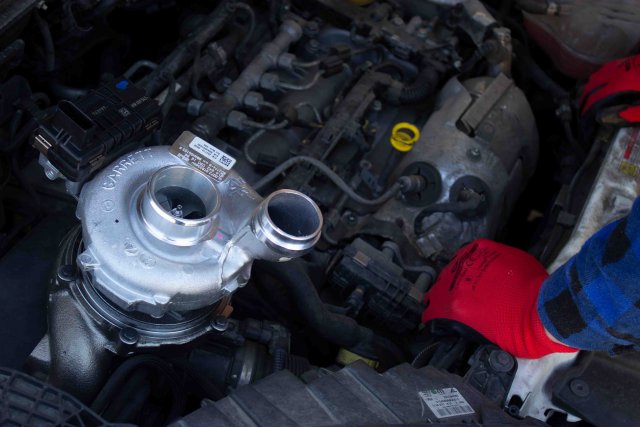Boost pressure in turbines: what is correct and reasons for failures

The turbine is the main component of the engine's turbocharging system. If it operates incorrectly, the boost pressure will be either above or below normal. This parameter is always checked during engine diagnostics because an incorrect gas flow can lead to further vehicle breakdowns.
An automotive turbine increases the vehicle's power while maintaining the original engine volume. Therefore, the proper functioning of this component helps keep the engine in good condition.
Which is more dangerous: turbo underboost or overboost?
Both symptoms result from the malfunctioning of several systems and reduce the car’s power. Therefore, each condition requires urgent repair.
During turbo operation, exhaust gases spin the turbine wheel, compressing the compressor section's incoming air, creating the necessary pressure. This compressed air enters the engine cylinders, increasing the oxygen available for fuel combustion, boosting power. The higher the boost pressure, the more air and fuel are burned, increasing potential power.
Every vehicle requires a specific turbo boost pressure, there are general ranges for different types of engines:
- Gasoline engines: 0.6 - 1.0 bar
- Diesel engines: 0.6 - 0.7 bar
What is turbo underboost: symptoms?
As long as the turbocharger is directly involved in creating the fuel-air mixture, poor boost will negatively impact the car's acceleration dynamics. A significant decrease in engine power and slow acceleration are signs of underboost. Though not immediately critical, this issue can lead to other failures over time.
A compromised seal in the pipes, loose connections in the system, or damage to the intercooler are often some of the primary and, at the same time, simplest causes of turbo underboost. Fortunately, these problems can be easily resolved:
- Replace or repair damaged pipes
- Ensure proper sealing of boost system components
- Repair or replace the intercooler
- Check the condition of the nozzle assembly and clean or replace it if needed
- Inspect the Wastegate valve
Underboost in variable geometry turbines
Variable geometry turbochargers improve engine performance at various speeds by adjusting the angle of the blades. Unlike standard turbines, where exhaust gas flow direction is constant, variable geometry optimizes boost at both low and high RPMs. This is achieved by altering the flow area and increasing turbine efficiency in different operating modes.
However, this design is prone to issues like carbon buildup on the blades, hindering their movement and leading to low turbocharger boost pressure, commonly known as "turbo lag." To fix this, it’s recommended to clean the turbocharger and address system faults. Apart from carbon buildup, a worn actuator valve can also cause geometry issues.
Types of actuator damage
The main reason for actuator failure is diaphragm aging. Over time, the diaphragm loses its seal, causing the valve to malfunction. As a result, the valve fails to respond correctly to pressure changes and stops regulating the turbocharger's operation.
Different types of actuator damage include:
- Sticking
Caused by carbon buildup on the nozzle assembly blades, reducing their mobility. - Vacuum leaks
Due to worn actuator membranes or damaged channels. - Corrosion
Electronic actuators are vulnerable to moisture, which causes rust on electrical connections. - Gear wear
Gears in electronic actuators are often made of plastic and can wear out or break over time, leading to incorrect turbocharger regulation.
If the diaphragm is damaged, the actuator can often be repaired. This process involves:
- Opening the wastegate housing
- Replacing the old diaphragm
- Cleaning the housing
What is turbo overboost: causes?
Turbine overboost occurs when the turbocharger creates higher-than-normal air pressure, leading to more aggressive fuel combustion than the engine is designed for. This process can be likened to a small explosion in a confined space, which can cause serious engine issues.
Overboost may occur for the following reasons:
- Malfunction of the turbo actuator
- Overused WasteGate valve – the surface of the valve or the turbocharger manifold under the valve has worn out, creating a hole through which air passes and turbo overboosts.
- Blocked variable geometry of the turbocharger – carbon buildup on the blades.
The main symptoms of overboost include unstable idle operation, the need to rev the engine constantly to avoid stalling, and a noticeable increase in combustion chamber temperature. If not addressed, overboost can lead to:
- Piston and valve burnout due to excessive heat
- Accelerated wear of the cooling system, which is designed for normal temperature operation
- Increased fuel consumption
- Turbocharger overheating, which destroys the oil film on components like bushings and bearings, potentially causing the turbo shaft to seize.
Ignoring turbo overboost can result in costly engine repairs. Persistent overheating and wear may require a full engine overhaul, including turbocharger replacement. And here creates a question: what do I need to do with overboost?
The solution of turbo overboost depends on the car, so you should visit a service center for diagnosis. The specialist may recommend:
- Dismantling the turbocharger and inspecting for defects;
- Replacing damaged turbo components;
- Tuning the turbocharger on a test stand under conditions similar to real-world operation.
By seeking professional help, you can avoid serious consequences and extend your car's life.
